by Juan José Santos Mateo // Jan. 12, 2021
“‘green’ is related both to the representation of nature/natural and to [the] techno-scientific. paradoxically, the colour green can never be manufactured as ‘green.’ despite the availability of plant-based materials, the pigments used to stabilize and technically fix green are always composed of some toxic substances. inorganic pigment Green 50 consists of cobalt, titanium, nickel, and zinc oxide, the same resource metals that are extracted for the current ‘green’ technologies.
greening ‘green.'”
This is an excerpt of a semi-poetic text that Kristina Õllek wrote for her new work ‘Powered By’ (2020), which was recently exhibited as part of the group show ‘Tiger in Space’ at the Contemporary Art Museum of Estonia (EKKM). The title of the piece alludes to so-called “green” technology, which, as Õllek affirms, in many cases carries a hidden side effect of greenwashing. Industrial green might be the end of natural green, as industry unequivocally changes nature for the worse. In ‘Powered By,’ Õllek reflects on cyanobacteria’s metaphorical value and physical presence within the concept of greenness.
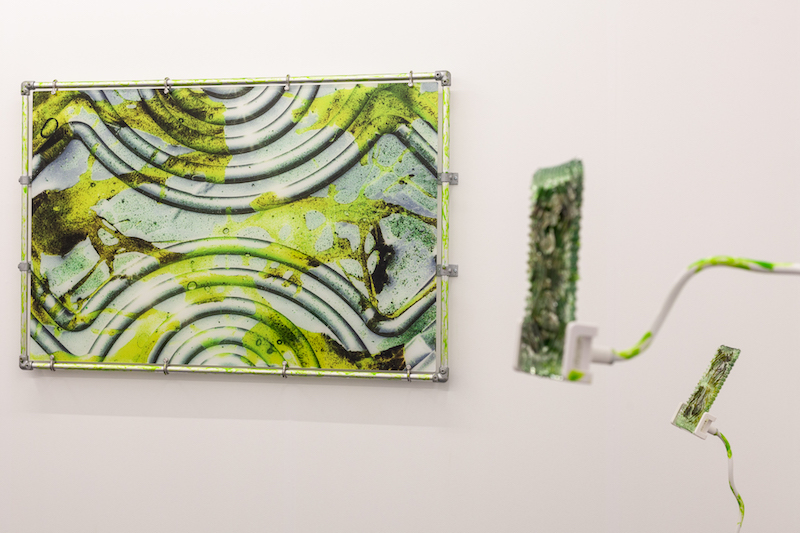
Kristina Õllek: ‘Powered By,’ 2020, installation view as part of ‘Tiger in Space’ at Contemporary Art Museum of Estonia (EKKM) // Courtesy of Kristina Õllek
Her earlier work ‘Nautilus New Era’ (2018) approached a similar theme, offering another kind of scathing critique of the “green economy,” as well as the topic of deep sea mining in the age of climate emergency. The installation consisted of four integrated elements: a video with its “special squishy seating,” two cobalt-pigmented sand piles with photographic sculptures laying on them, and a large-scale photographic work. In this piece, Õllek mixes fiction, as well as aspirations, with reality. Drawing from Jules Verne’s story ‘Twenty Thousand Leagues Under the Sea,’ Õllek specifically considers the moment when Captain Nemo assures Professor Aronnax that there were precious metals at the bottom of the sea, confirming that mining them was profitable. Beginning with this speculative fascination spurred by fiction, we quickly find that the fantasy ends up itself devoured by the temptation to commercialize it. In Õllek’s piece, Nemo’s proposal comes true with Nautilus Minerals Inc.—sharing its name with the submarine in Verne’s story—a corporation that excavates minerals such as gold, silver, nickel and cobalt from the seabed near Papua New Guinea. We spoke to Õllek about how her practice questions the human impulse to colonize nature for economic pursuits.
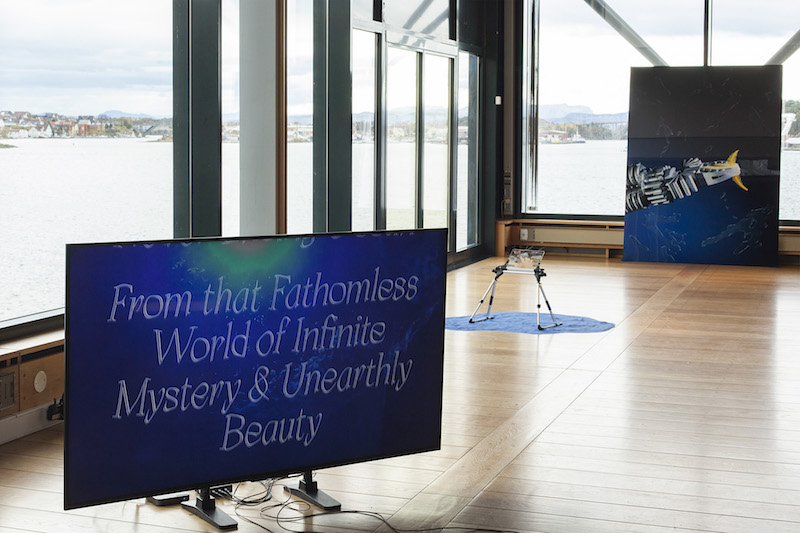
Kristina Õllek: ‘Nautilus New Era,’ 2018, installation view, commissioned by Le Lieu Unique and Art Museum of Estonia (KUMU) // Courtesy of Kristina Õllek and Art Museum of Estonia (KUMU)
Juan José Santos Mateo: In ‘Nautilus New Era,’ instead of focusing on consequences or making something closer to a documentary, you wanted the spectator to simulate that they’re extracting minerals, attempting to make them understand the extractivist model.
Kristina Õllek: With the ‘Nautilus New Era’ installation I was interested in creating an artificial seabed that would resonate with the deep-sea scientific research, the problematics of deep-sea mining and hybrid fiction. Opening the topic and problematics of the deep sea and its mining, the work is commenting on the idea of touch, sometimes more in terms of the distant robotic arm and digital network, sometimes more physically, but all within an alienated artificial situation. By using similar materials as those used for the soft robotic arms—memory foam and silicone rubber—I wanted to give the viewer a physical, squishy experience while sitting and watching, to feel the “squishy grip” as seen in the video.
In addition, I wanted to highlight the naive extractivist perspective presented through the mining companies’ renderings and publicity videos. Most of the Nautilus Minerals Inc. publicity videos that were available used renderings to showcase the process, because nothing like this (thankfully!) has ever been tested in the deep sea. Those renderings were created in such a simple and naive manner, as if the seafloor surface were just an empty floor with metallic nodules. It was as if everything were as clean and easy as shown, while in reality it’s something quite opposite, with heavy consequences and a huge impact on biodiversity and on the Earth more generally.
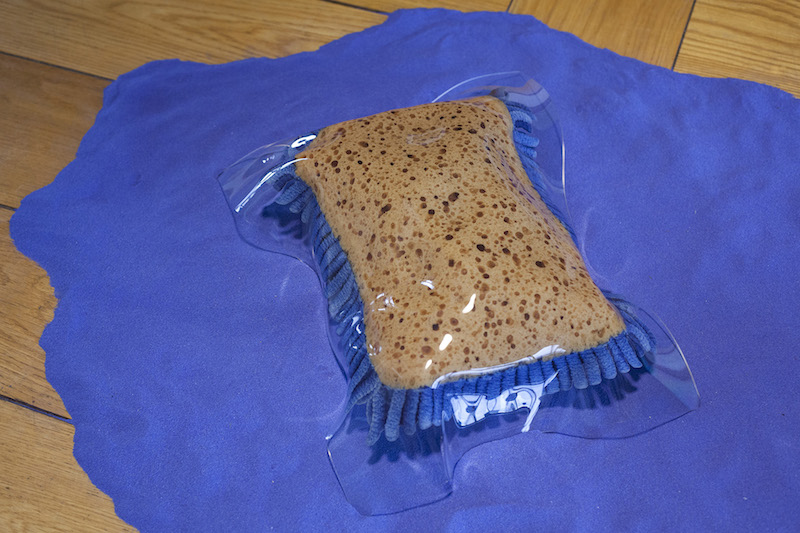
Kristina Õllek: ‘Nautilus New Era,’ 2018, installation view, commissioned by Le Lieu Unique and Art Museum of Estonia (KUMU) // Courtesy of Kristina Õllek and Art Museum of Estonia (KUMU)
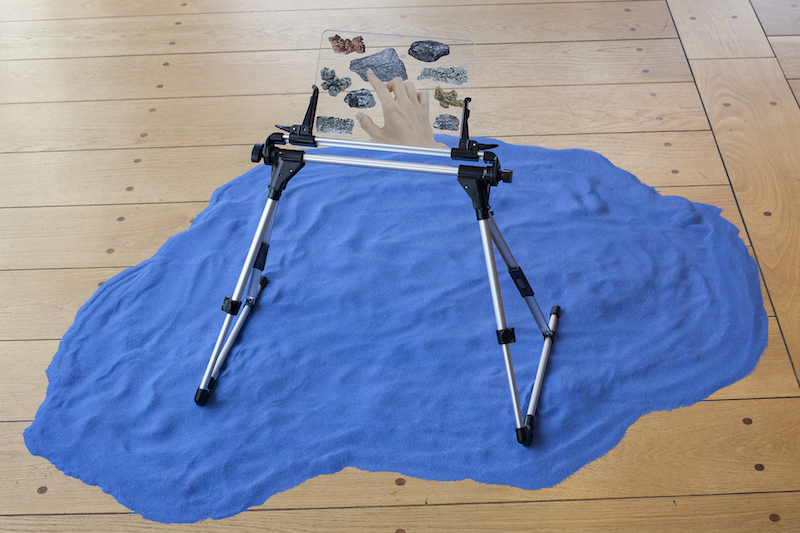
Kristina Õllek: ‘Nautilus New Era,’ 2018, installation view, commissioned by Le Lieu Unique and Art Museum of Estonia (KUMU) // Courtesy of Kristina Õllek and Art Museum of Estonia (KUMU)
JJSM: Do you believe extractivism is something more than an industrial formula, that it could be considered a way of life or an individual attitude?
KÕ: From classical antiquity to the 18th century, it was often believed that stones and metals grew beneath the Earth like organic matter. Though we know that they are limited, non-renewable resources, we humans—mainly transnational companies and powerful nation states—act as if there’s an abundance, always in reach, and colonize nature as much as needed for the sake of economic growth. The attitude towards recycling and a circular economy is still something that’s not prioritized enough. We see the Earth through mediated technologies and visualizations, we grasp the Earth through the digital interface and mapping, but not yet from a holistic and planetary view. There’s the constant need and conquest, to extract more, to get more. It’s part of the industrial formula that is packaged as a way of life. I remember reading that there’s a plan to mine on the Moon to fuel the rockets. It all sounds like a plot from science fiction, but this is something that’s being considered for real. For example, in May 2020, NASA proposed a legal framework for mining on the Moon. I wonder what kind of long-term after effects this could lead to on the Moon, and therefore also on Earth.
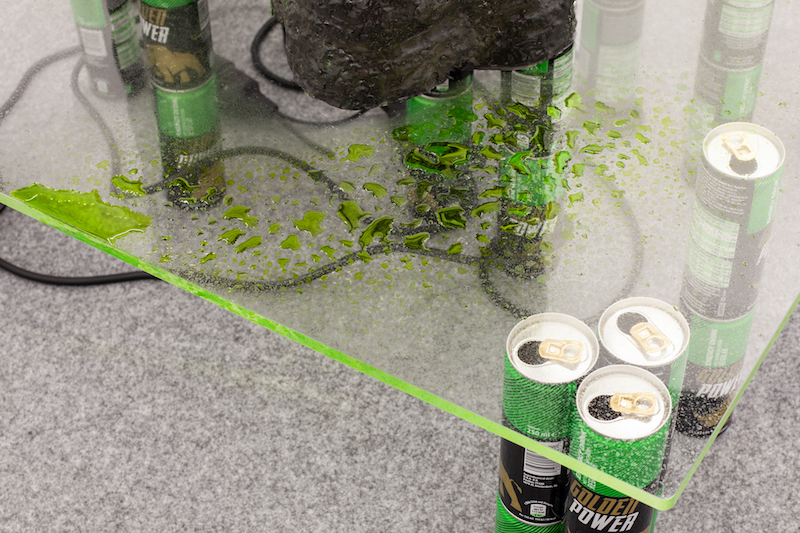
Kristina Õllek: ‘Powered By,’ 2020, installation view as part of ‘Tiger in Space’ at Contemporary Art Museum of Estonia (EKKM) // Courtesy of Kristina Õllek
JJSM: Can you tell us about the themes touched on in ‘Powered By’?
KÕ: ‘Powered By’ is a work that focuses on excess energy and renewable “green” energy, by questioning the concept of greenness through its metaphorical value and physical presence of cyanobacteria. The installation can be seen as a speculative “green” power station that explores the notion of energy transition powered by cyanobacteria, harmful algal blooms, solar energy, energy drinks, fertilizers and toxic green matter.
JJSM: ‘Powered by’ is accompanied by a semi-poetic text that you wrote for the publication, in which you talk about the paradox of using toxic substances in order to manufacture the colour green. In ‘Nautilus New Era,’ you also show how to artificially create nature through digital or robotic interfaces. Why are you interested in this paradox and in this context?
KÕ: These kinds of paradoxes and double-bind scenarios are something that have always been interesting to me. Throughout my practice, I’ve been attentive to the intersection of natural and artificial states of being. I’m curious about how we perceive that relation, how we expand the idea of a representation and how it could be addressed and discussed. In my practice, I’m frequently using situations in which fact and fiction, synthetic and natural, copy and original intertwine with each other and become a hybrid object or matter to obtain new and reconsidered meanings. The age of digital hi-tech devices has rapidly changed our understanding of presence, as well the past and future. I find it crucial to see behind the captivating liquid crystallized screens and technologies, to acknowledge the surrounding and base, with its geological “roots” and rhizomatic structures.
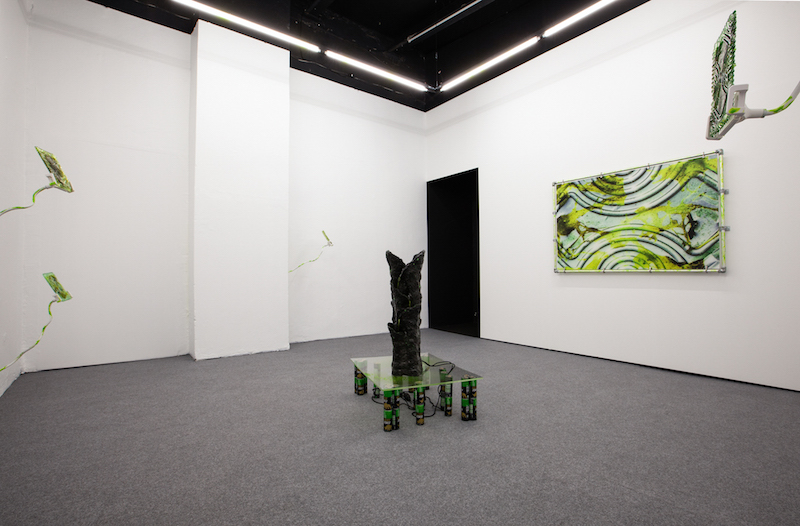
Kristina Õllek: ‘Powered By,’ 2020, installation view as part of ‘Tiger in Space’ at Contemporary Art Museum of Estonia (EKKM) // Courtesy of Kristina Õllek
JJSM: Artificiality and the inherent toxicity of the colour green is related to the harmful blue-green algal blooms that appear as a side effect of environmental pollution and climate change. Does this introduce the idea that there is hope, and that nature itself is rebelling against us?
KÕ: Nature has shown signs of various problems already over many decades, many of which are not admitted by prosperous countries, as they enjoy comforts that have been enabled through exploitation. Powerful states and transnational industries have never taken the blame for extracting, which has caused lots of problems outside of their own safe horizons. The history of exploitation of nature and humans goes back hundreds of years, since the beginning of colonialism. I think we should rebel, together with nature, against the neoliberal extraction system that pushes us to always consume more and destroy nature and lives in the pursuit of profit. The world is deeply interconnected, planetary and human health are entangled. Our current pandemic is another wake-up call from an unbalanced ecology, showing how interconnected we truly are.
This article is part of our feature topic of ‘Extraction.’ To read more from this topic, click here.



















